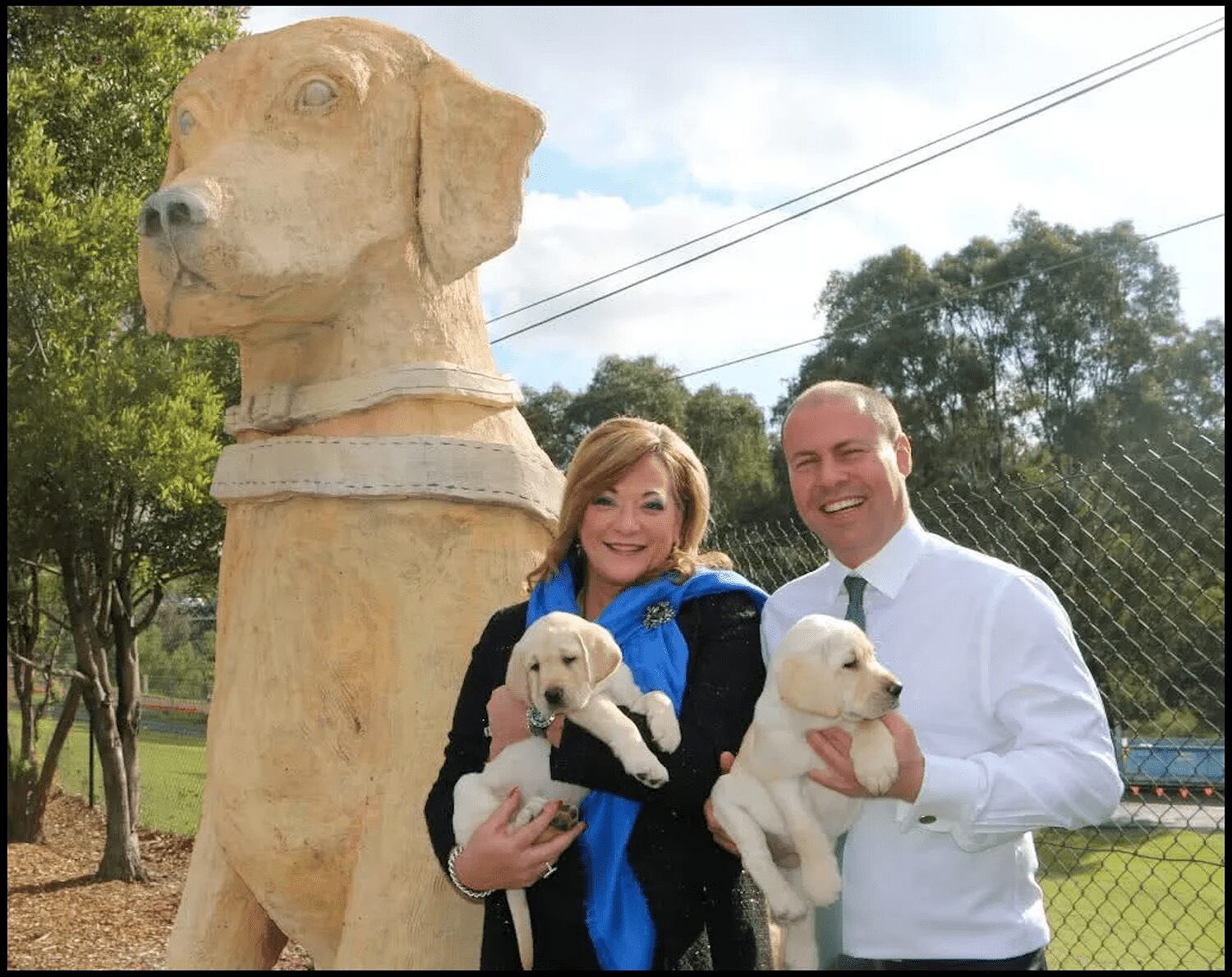Appreciate our quality journalism? Please donate here
EXCLUSIVE INVESTIGATION
A Melbourne “charity” whose CEO almost certainly broke federal laws by officially spruiking a sitting member of parliament is charging taxpayers four times what it was a decade ago to deliver just three-quarters of the services.
An in-depth investigation by The Klaxon reveals Guide Dogs Victoria paid its disgraced CEO Karen Hayes increasingly eye-watering salaries over the past ten years, during which time its annual wages bill surged 40 per cent, from $6.37 million to $9.44m.
Last financial year it delivered just 35 guide dogs.
The taxpayer funds Guide Dogs Victoria received for its ongoing operations exploded from $1m a year a decade ago to $3.9m last year.
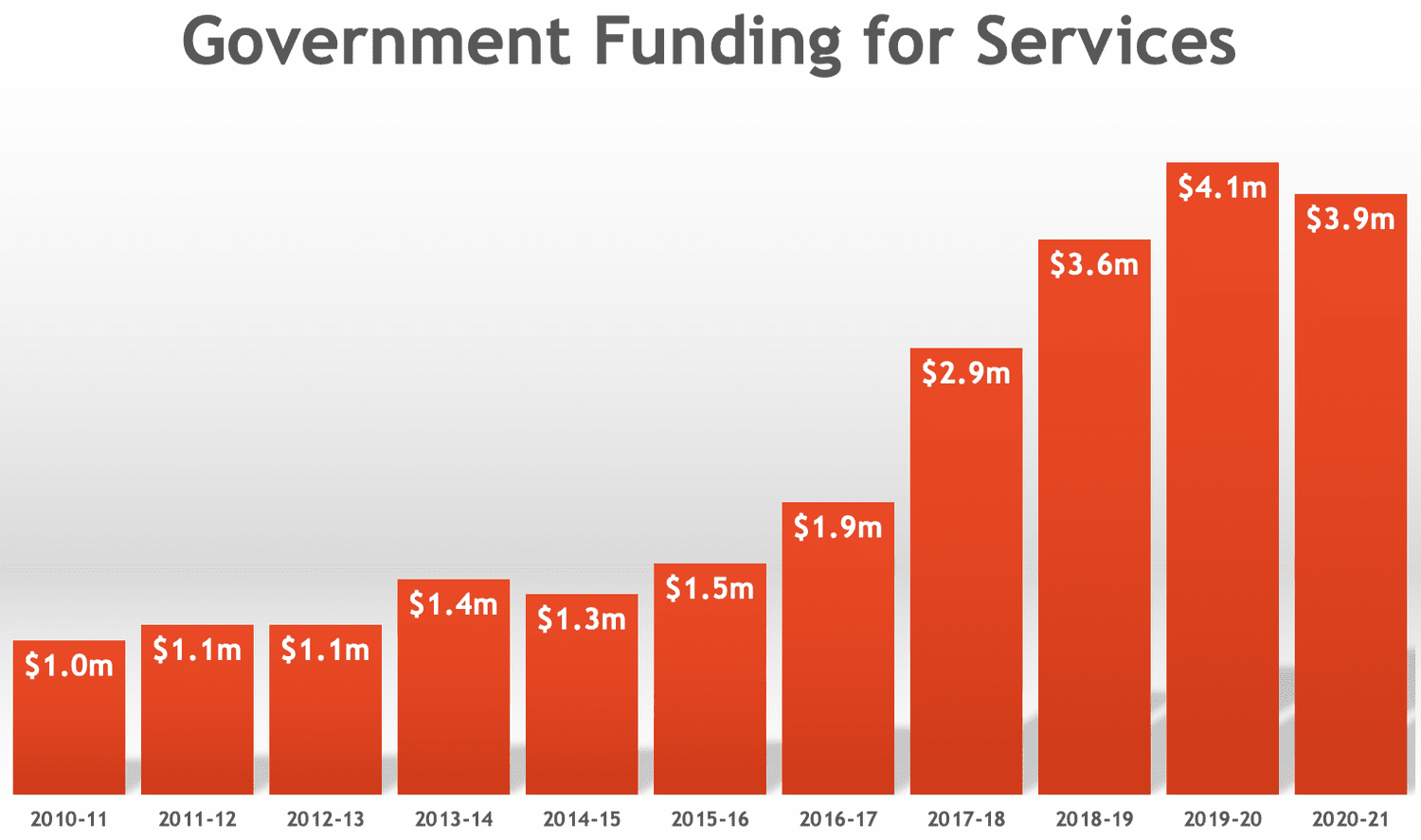
Australian taxpayers are paying four times the amount for Guide Dogs Victoria’s ongoing operations than they were a decade ago, despite services plummeting. Source: Guide Dogs Victoria. Graphic: The Klaxon
That’s before counting well over $10m the charity has received in government grants for numerous “redevelopments” at its Melbourne headquarters since 2013 – much of it in pre-election announcements by the Federal Coalition.
Yet the services Guide Dogs Victoria is providing to the public has plummeted.
“The services Guide Dogs Victoria is providing to the public has plummeted”
The number of “guide dog users” it is servicing each year – as well as the total clients it is “assisting” – have each fallen by 25 per cent compared to a decade ago.
Last financial year Guide Dogs Victoria allocated just 35 guide dogs to the blind or vision impaired – the same number as a decade earlier.
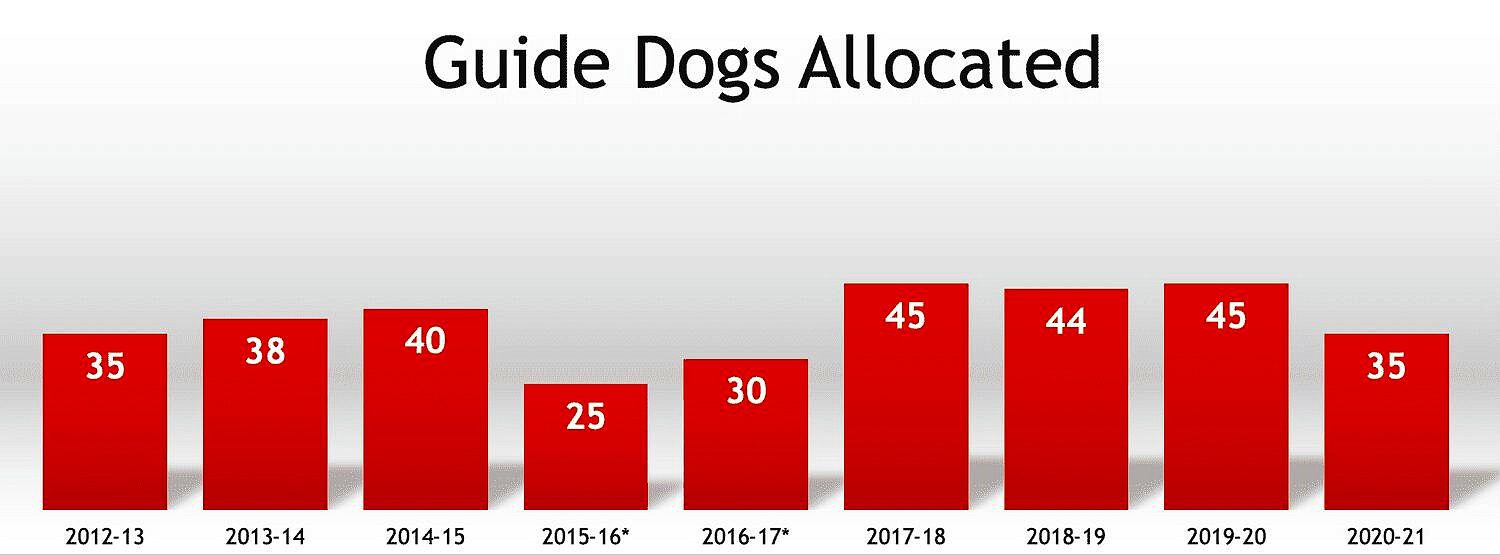
Australian taxpayers are paying four times the amount for Guide Dogs Victoria’s ongoing operations than they were a decade ago, despite services plummeting. Source: Guide Dogs Victoria. Graphic: The Klaxon
That taxpayer funding for its ongoing operations – which it terms “government funding for services” – is before including millions of dollars in “grants” for “redevelopments” at the charity’s headquarters in the inner-Melbourne suburb of Kew.
Those “redevelopment” grants started the day before the 2013 Federal Election, when the Federal Coalition promised $2m, kicking off a decade of taxpayer-funded largess.
Those “redevelopment” grants include:
– $2m announced by the Federal Coalition the day before the 2013 Federal Election;
– A major Federal Coalition grant paid just before the 2019 Federal Election (value undisclosed);
– A $2.5m Federal Coalition grant announced in 2020; and
– A $5m Victorian Government grant in 2018
In addition, as previously revealed, in 2020 and 2021, Guide Dogs Victoria received $3.5m under Frydenberg’s JobKeeper program that it didn’t need.
(The cash went to bolstering its “cash at bank” to $18.75m, up from $16.65m a year earlier.)
The slump in services provided by Guide Dogs Victoria is despite surging demand.
In 2012 the charity reported there were “220,000 blind or vision impaired people” living in Victoria, with that figure “predicted to grow to 350,000 by 2020”.
Karen Hayes “resigned” as Guide Dogs Victoria CEO on Tuesday last week, six weeks after it emerged she had appeared in political advertisements spruiking then Federal Treasurer Josh Frydenberg for re-election.
It is illegal for charities to promote politicians or political parties, in laws heavily advocated by Frydenberg and the former Federal Coalition Government.
Investigations by The Klaxon show Hayes – whose remuneration is listed in the charity’s accounts under “Key Management Personnel” – was paid a salary of $298,678 in 2013-14.
Last financial year that figure had ballooned to $553,000 – which is more than half what the charity used to receive in total government funding every year.
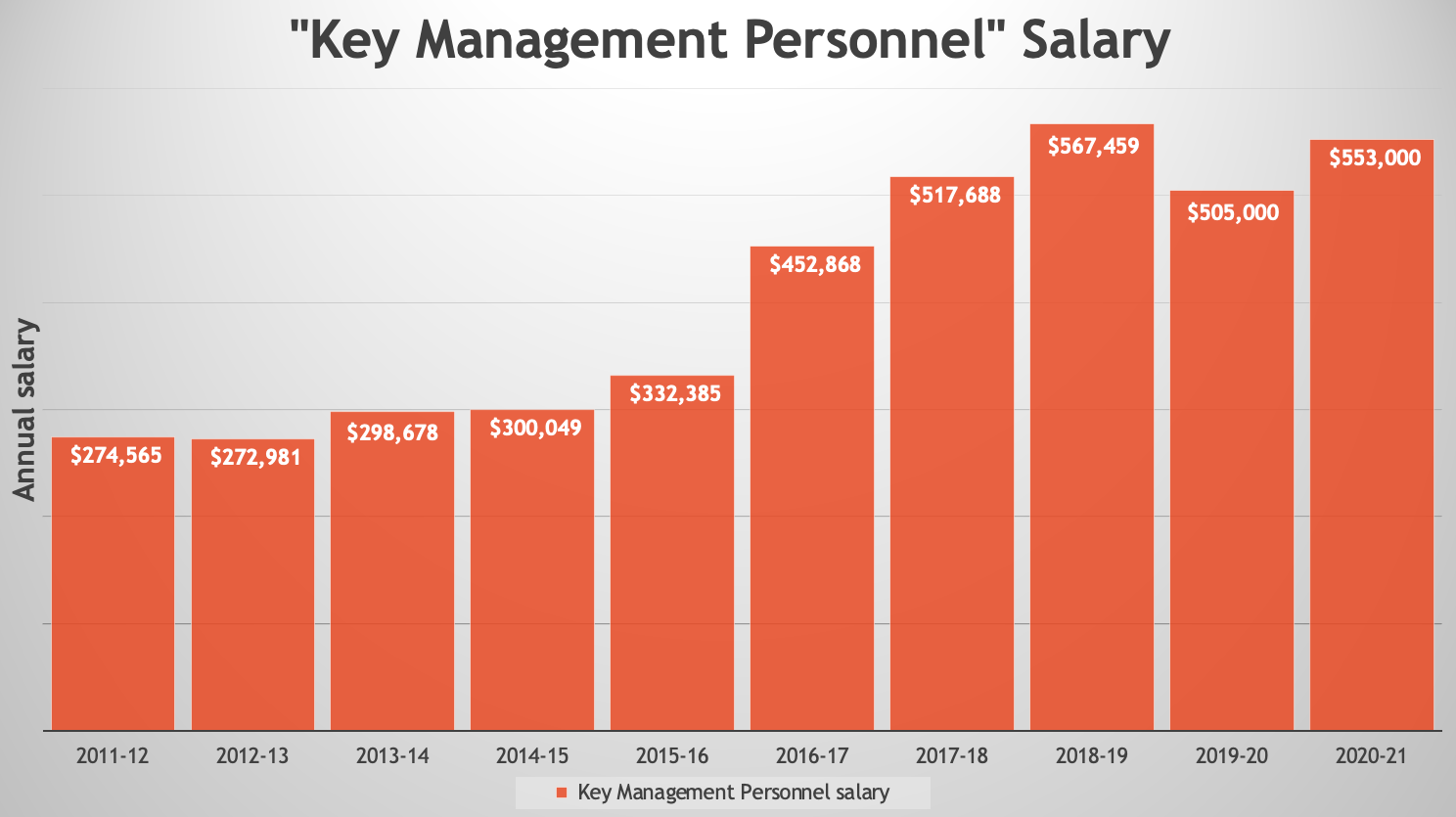
Karen Hayes was paid an eye-watering salary as charity CEO. Source: Guide Dogs Victoria and ACNC. Graphic: The Klaxon
In the 2011, 2012 and 2013 financial years – Hayes’ first three years as CEO – Guide Dogs Victoria received total government funding of between $1m and $1.1m each year.
In the 2019, 2020 and 2021 financial years it received annual government funding of $3.6m, $4.1m and $3.9m respectively.
The surge in taxpayer funding for its ongoing operations was underpinned by ballooning payments under the National Disability Insurance Scheme (NDIS).
The NDIS started on July 1, 2013.
Despite the charity’s poor performance, its NDIS payments surged from $1m in 2016-17 to $3.1m in 2019-20 and $2.8m last financial year.
NDIS CEO Martin Hoffman was appointed to the role by the Federal Coalition in November 2019.
The NDIS has been criticised for major cost blow-outs and the ALP, when in opposition, raised serious concerns over Hoffman’s performance.
On Wednesday it was announced Hoffman had “resigned”.
On Friday last week it was announced Gary Johns, the Coalition-appointed, highly-controversial boss of charities regulator the Australian Charities and Not-for-Profits Commission (ACNC) had also “resigned”.
That move was “welcomed” by Dr Andrew Leigh, the new Assistance Charities Minister.
“The election ended the Liberals’ nine-year war on charities,” Leigh said.
Last month The Klaxon exclusively revealed the ACNC was falsely claiming “secrecy provisions” in the ACNC Act meant it was legally prevented from commenting on the scandal engulfing Hayes and Frydenberg.
Before being appointed to head the ACNC by the Federal Coalition in 2017, Johns had run an anti-charity arm of the “Institute of Public Affairs”, a secretive US-style, dark money lobby group.
Guide Dogs Victoria’s board has repeatedly refused to respond to written questions from The Klaxon regarding its financial position and its payments to Hayes – including refusing to confirm her salary.
Hayes has also repeatedly refused to comment.
Frydenberg was the member for Kooyong, in Melbourne’s inner-east, between 2010 and late last month, when he lost the seat at the Federal Election to independent Dr Monique Ryan, a neurologist.
Guide Dogs Victoria is located in the suburb of Kew, which, as Frydenberg said in a May 2013 speech to Federal Parliament, is “in the heart of my electorate of Kooyong”.
He was appointed Federal Treasurer and deputy leader of the Liberal Party four years ago, in August 2018.
It was Frydenberg who directed much of the taxpayer funding to Guide Dogs Victoria over the past decade.
He has repeatedly declined to comment when contacted by The Klaxon.
Silence
On April 20 it emerged that Guide Dogs Victoria CEO Hayes had appeared in advertisements spruiking Frydenberg, under the headings: “Why I am voting for Josh Frydenberg” and “Why I am supporting Josh Frydenberg”.
On that day the Guide Dogs Victoria board released a statement saying it had launched an “internal investigation”.
The board claimed to have been unaware of the ads before they were published.
Frydenberg was forced to pull the Hayes advertisements, along with similar ads he had run featuring Cate Sayers, the founder of charity Inclusion Foundation. (More on Sayers here and here.)
A week later, on April 26, the Guide Dogs Victoria board released a statement saying Hayes had been “stood down” pending an “internal investigation”.
(Guide Dogs Victoria has since deleted those April 20 and April 26 announcements from its website).
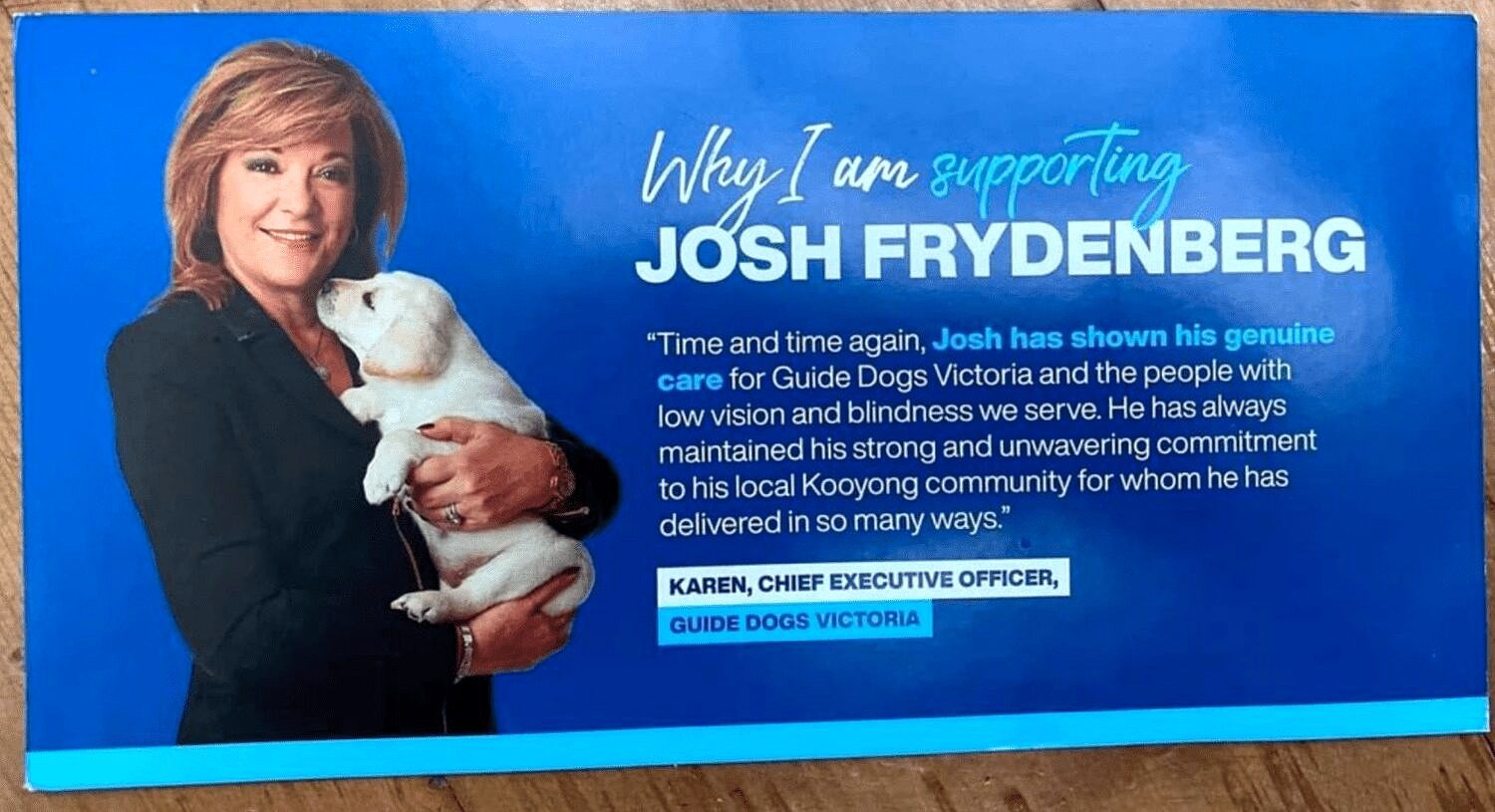
Karen Hayes in one of the Frydenberg advertisements. Source: Josh Frydenberg
Just over two weeks ago, on the night of the federal election, Frydenberg fronted the nation’s TV cameras having received a drubbing in the polls.
The then Federal Treasurer gave a “shout-out” to Hayes, who he said was “one of the best CEO’s in Australia”.
He provided no context to the statement.
On Monday evening last week, two days after the federal election, The Klaxon put a series of questions about Hayes and the Frydenberg advertisements to the Guide Dogs Victoria board.
The board did not respond but the following day it and Hayes released statements saying Hayes had “resigned”.
Those statements make no mention of the scandal that saw Hayes ousted.
Guide Dogs Victoria spokesman Tim Lele, from external communications company Keep Left, told The Klaxon the “internal investigation” – launched six weeks earlier – was being conducted by an external party and that it was ongoing.
The board of Guide Dogs Victoria repeatedly refused to comment when asked why the investigation remained ongoing, who was conducting it, how much it was costing the charity, and whether its findings would be released to the public.
Current board members include Charles Thompson, a “mergers and acquisitions” lawyer and former senior executive at Toll Holdings and Australia Post; David Cochrane, a former Ernst Young and PriceWaterhouseCoopers accountant who now runs a private “consultancy” servicing government; and Bruce Brook, a former ANZ Bank executive who is currently a director of Newmont Mining Corporation and chemicals company Incitec Pivot Limited.
Chair Iain Edwards, who is vision impaired and uses one of the charity’s guide dogs, is a physiotherapist.
He joined board as a director in 2011 and became chair in 2018-19.
Thompson, who was also formerly a management consultant with Boston Consulting Group, joined the board as director in 2014 and was chair from 2015-16 to 2018-19.
The board of the charity moved to being far more “corporatised” from mid-2015.
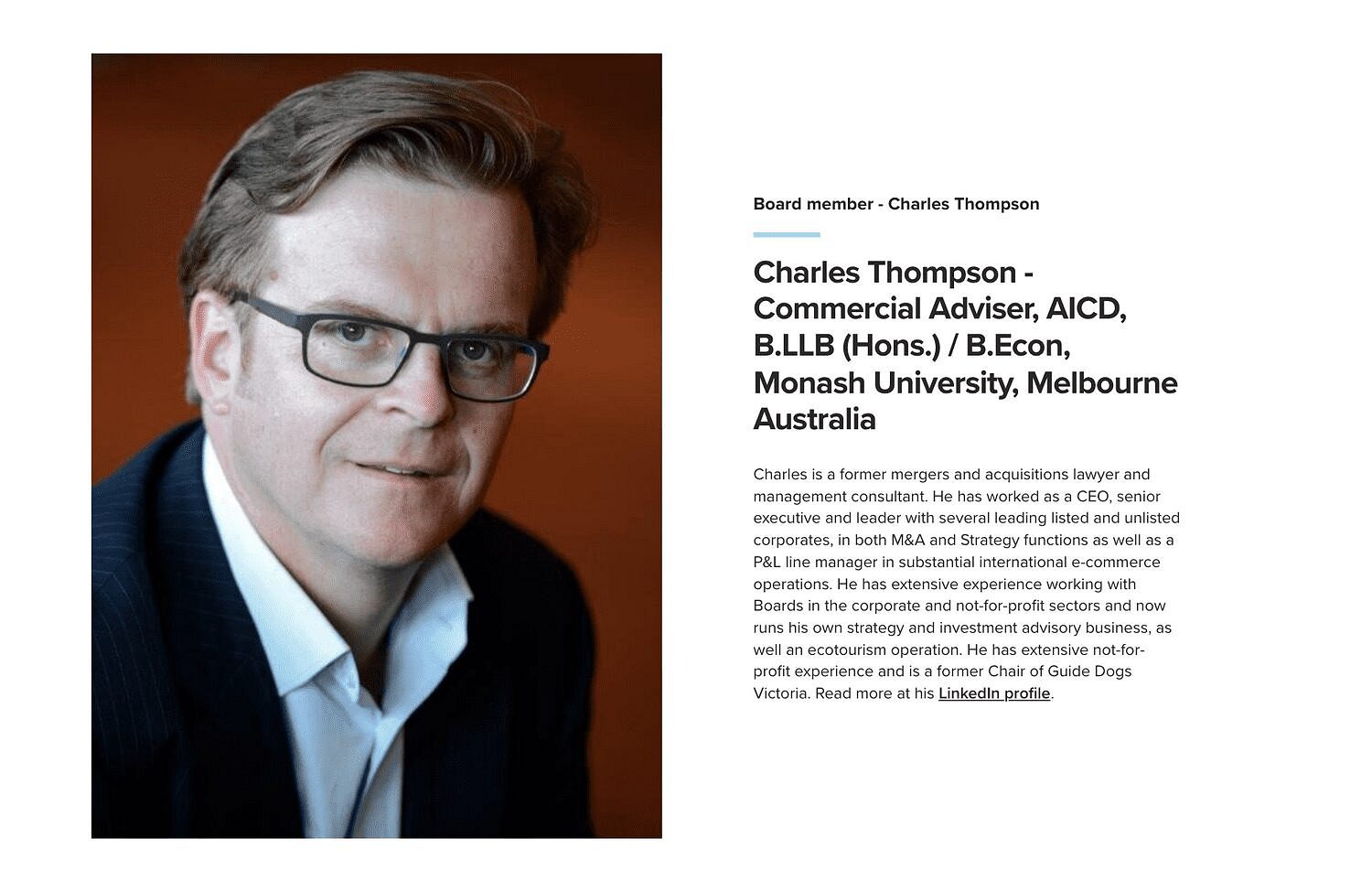
Charles Thompson. Started as chair in 2015-16. Source: Guide Dogs Victoria
Before then the chair was Russell Walker and deputy chair was John Rayner.
Walker’s bio in the charity’s 2015 annual report states that he previously spent 20 years as the Auditor General of Victoria and that he a “and his wife Marlene have been contributors in various areas of Guide Dogs Victoria” for “over 22 years”.
Rayner’s bio states his background is in software development and “IT education”, that he had been appointed a director in 2010, and that “he and his wife Anne have been Puppy Raisers with Guide Dogs Victoria since 2000”.
Both men left amid the 2015 board overhaul.
Determining exactly how much Guide Dogs Victoria has cost taxpayers in recent years is difficult because its reporting becomes increasingly patchy from 2015.
That was also when Guide Dogs Victoria stopped reporting its key information in a single annual report, instead publishing it across up to four separate documents.
The Klaxon has analysed every document the charity has published over the past ten years.
Between 2010 and 2013 its cost to taxpayers is clearly identified, and appears as “government grants”, which total just over $1m in each of those three years.
From 2013, when the NDIS began, and 2017, when Guide Dogs Victoria started identifying its NDIS receipts as such, there is another revenue category.
It’s called “government grants for services” and it’s in addition to the existing “government grants” category.
Between 2013 and 2017 payments to the charity under that new category (which appear to be mostly, if not entirely, NDIS payments) average just under $400,000 a year.
In the 2018 to 2021 financial years the charity’s receipts under the NDIS are more clearly identified.
They grow from $1m a year in 2018 to around $3m a year in each of the past two financial years.
On top of those payments are the $10m-plus in government grants the charity has received for various “redevelopments”.
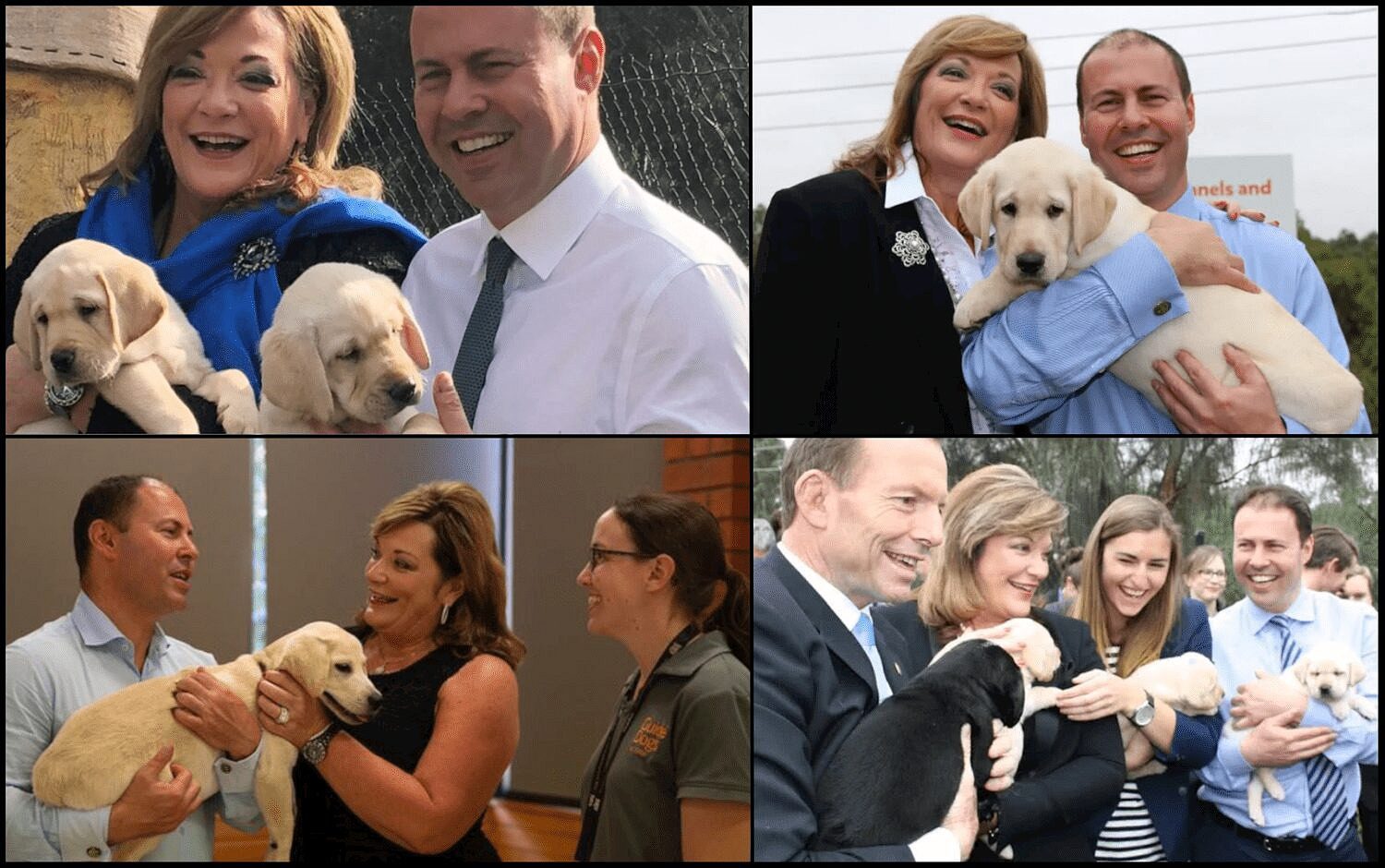
Frydenberg with Hayes on four seperate visits to Guide Dogs Victoria in recent years. Bottom right also pictured with Tony Abbott. Source: Supplied
The Klaxon publicly announced this coming investigation on Monday.
Statements regarding the Guide Dogs Victoria grants were removed from Frydenberg’s website sometime between then and Thursday afternoon.
The Klaxon took screen shots last week.
(The relevant links above were captured by internet archive Wayback Machine on May 22, the day after the federal election.)
Upgrade
On September 6, 2013, Tony Abbott, Joe Hockey and Frydenberg visited Guide Dogs Victoria’s Kew complex and announced that, if elected, the Coalition would provide $2m to Guide Dogs Victoria to “upgrade its veterinary clinic, custom boarding kennels and breeding centre”.
The Coalition won the federal election the next day, with Abbott becoming Prime Minister and Hockey Federal Treasurer.
Guide Dogs Victoria said the funds meant it could “make an unprecedented level of essential infrastructure” which “will better support the expansion of our current dog breeding program”.
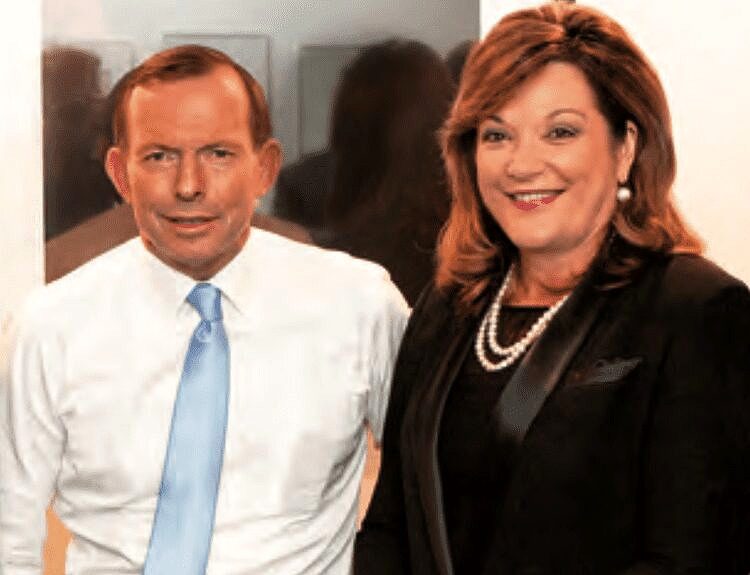
Tony Abbott visits Guide Dogs Victoria in September 2013. Source: Guide Dogs Victoria
In March 2016, ahead of that year’s federal election, Frydenberg visited Guide Dogs Victoria to “officially open” the new facilities funded by the $2m grant, which the charity said had allowed it to “upgrade and modernise its facilities”.
“The result is that Guide Dogs Victoria now has 55 sleeping kennels and 11 kennel yards, as well as three new whelping rooms capable of housing up to 30 pups,” Frydenberg said.
(Guide Dogs Victoria’s account show those “significant works” were funded by the Coalition’s $2m along with two donations from the public totalling $1.24m).
Despite that upgrade, and against the backdrop of surging taxpayer funds for its ongoing operations, the services delivered by the charity have slumped.
In the 2012 and 2013 financial years it provided services to 275 and 303 total “guide dog users” respectively.
Last financial year that had fallen to just 243.
“Last financial year that had fallen to just 243”
(Guide Dogs Victoria provides ongoing services to guide dog users who have previously been allocated guide dogs).
The total number of “clients assisted” is a broader measure which also includes people the charity provided “mobility” or “orientation” services to, such as instruction on how to use a cane or use public transport.
It also fell substantially – from 1614 clients in 2012-13 to just 1227 last financial year.
That is, Guide Dogs Victoria was “assisting” over 30 per cent more clients a decade ago.
In 2018 Frydenberg announced another major Guide Dogs Victoria grant (the value was not disclosed) when he visited on June 5 that year. The grant was paid to the charity just before the May, 2019 Federal Election.
Then, in April 2020, Frydenberg and McCormack announced another $2.5m – again for a “facilities upgrade”, this time to create “the world’s first state-of-the-art sensory campus”.
“I am thrilled the Federal Government is able to invest $2.5 million in this project which will benefit the many Victorians who require a Guide Dog or other services due to blindness or low vision,” Frydenberg said.
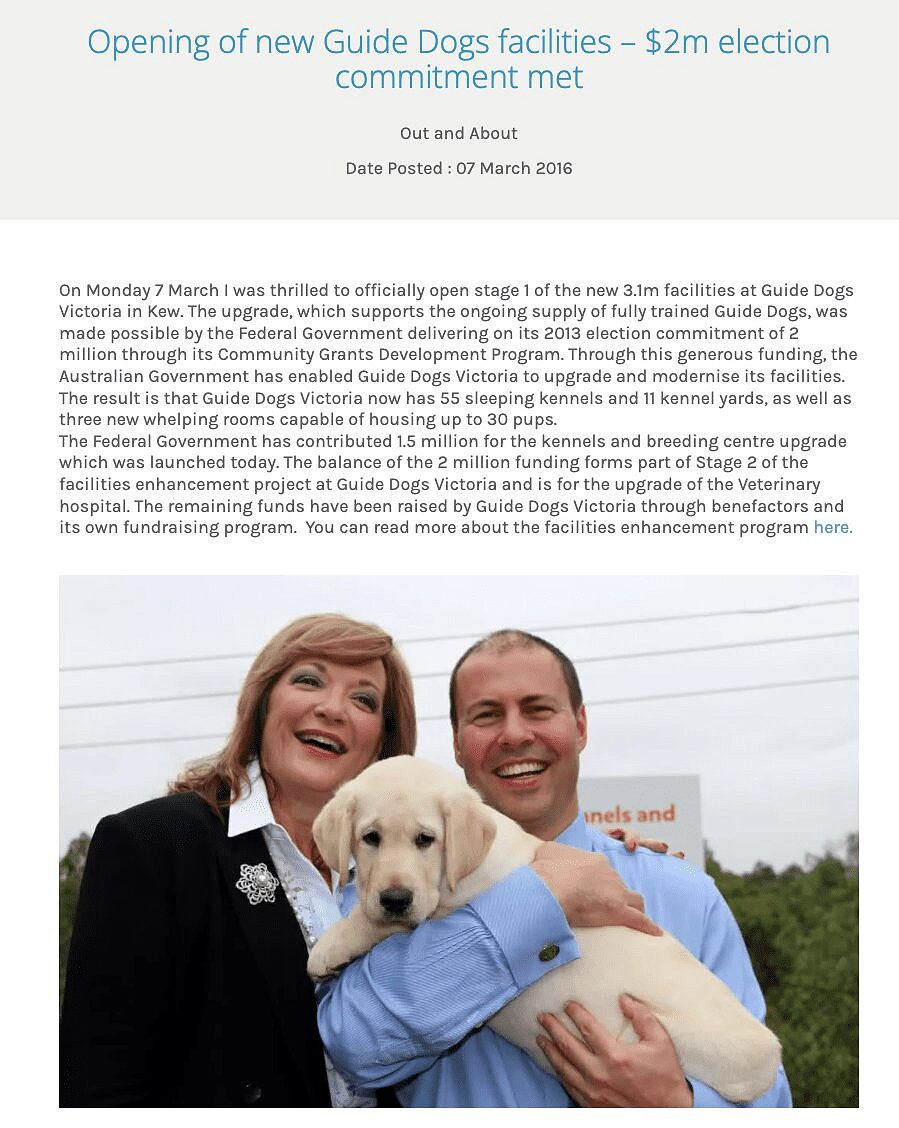
Frydenberg announcing the September 2013 $2m grant has been paid. Source: Office of Josh Frydenberg
The need for the services of Guide Dogs Victoria was “greater than ever”, Frydenberg said, with “approximately 15,000 Victorians diagnosed with some form of irreversible vision loss every year”.
In 2018 the charity received a $5m grant from the Victorian Government for the proposed “state-of-the-art sensory campus”.
The ACNC website contains “Annual Information Statements” for Guide Dogs Victoria, which from 2013-14 include a figure titled “revenue from government including grants”.
How that figure is calculated is unclear, although analysis shows it understates the total amount of money received from taxpayers.
For example, only $1.1m of the Victorian Government’s $5m is shown, due to an accounting measure whereby those payments are only recorded incrementally, as the development progresses.
Regardless, the data shows surging taxpayer funding.
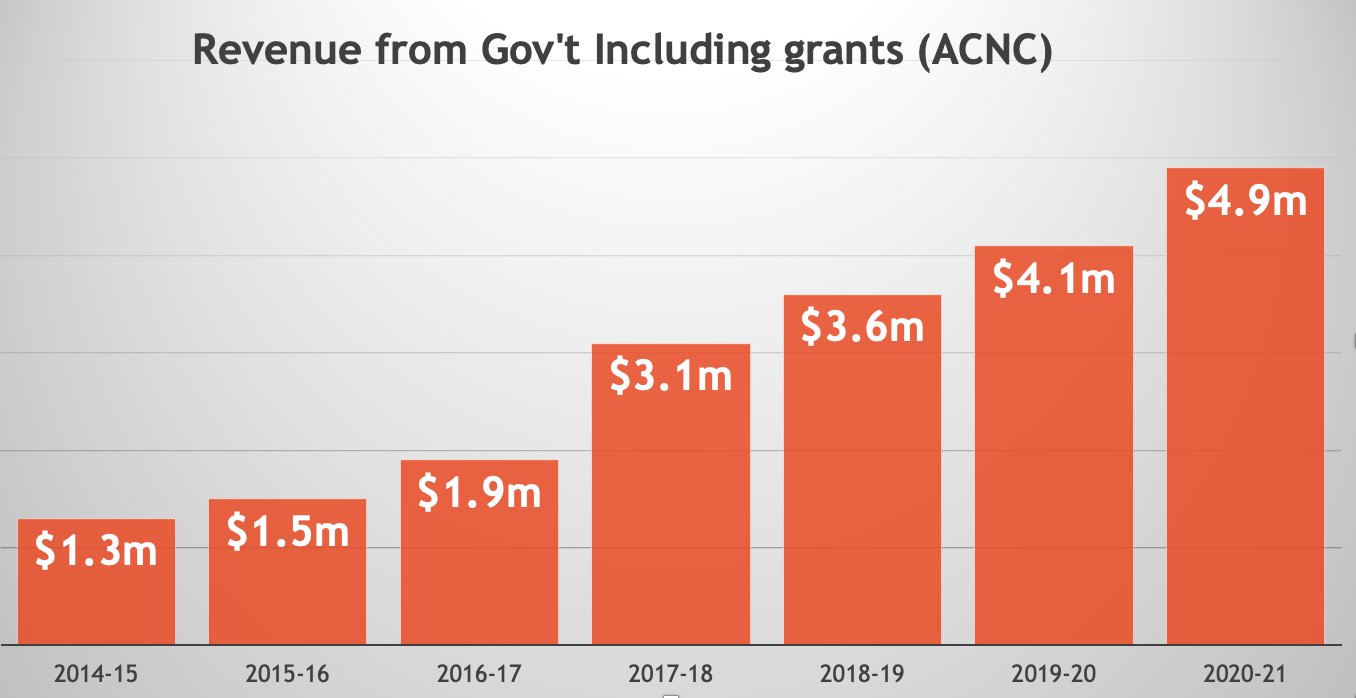
Source: Guide Dogs Victoria and ACNC. Graphic: The Klaxon
Dog Days
Our detailed analysis reveals the number of guide dogs “allocated” fell from 45 in 2019-20 to 35 last financial year, which was the same number as a decade earlier.
Despite it being the charity’s core reason for existing, determining this information from its annual reporting data is challenging.
Guide Dogs Victoria presents the figures as a combined total of guide dogs and “other assistance dogs” allocated.
Other assistance dogs are “pets as therapy dogs”, “companion dogs”, “breeding dogs” and “PTSD dogs”.
The overall levels are similarly low. In 2020-21 there were 66 “guide dogs and other assistance dogs” allocated, down from 74 the year before.
Over the past decade the only times the charity did not – at least somewhere in its accounts – also report the figure of “guide dogs” allocated was in the 2015-16 and 2016-17 financial years.
Those two years were when the charity allocated its lowest number of “guide dogs and other assistance dogs” (37 in 2015-16 and 45 in 2016-17).
(In the graphic at top, for those two years, The Klaxon has estimated the “guide dogs” provided based on the proportion of guide dogs to “other assistance dogs” allocated in the other eight years of the decade.)
The charity has published an “audited Performance Statement” as part of its annual accounts since 2015.
It stipulates guide dogs allocations are a “key performance indicator” with annual targets set by the “Guide Dogs Victoria strategic review”.
The charity failed to meet every one of its guide dog allocations targets (including by 34 per cent in 2015-16 and by 33 per cent in the 2016-17).
In 2019, after missing the guide dog allocation targets for four consecutive years, it stopped publishing targets altogether.
The impact of the systemic, and ongoing, sub-standard performance of Guide Dogs Victoria is unclear: the charity stopped reporting how many people were on its guide dog waiting list from 2015.
(It was 14 people in each of the 2013 and 2014 financial years).
In its financial report for the 2014 financial year, the charity clearly sets out the “total compensation” paid to Hayes, and it is broken down between “short-term benefits”, “post-employment benefits” and “other long-term benefits”.
Under the heading “key management personnel” it reports the total compensation paid to “the person” having authority over “controlling the activities of the company”.
(Hayes’ total remuneration that year was $298,678, it shows.)
From 2015 the description changes slightly, and instead refers to “any person(s)” having authority over controlling the activities of the company.
This introduces the possibility that those “key management personnel” payments could include people other than Hayes, although it appears this is almost certainly not the case.
All financial reports state the directors of the charity are unpaid.
The breakdown of the types of compensation (ie short-term, long-term etc) also disappears from 2015.
At the same time, the total annual compensation figure starts to surge.
It is $332,385 in 2015-16; $452,868 in 2016-17; $517,688 in 2017-18; $567,459 in 2018-19; $505,181 in 2019-20 and $535,000 in 2020-21.
According to her LinkedIn profile, Hayes “is recognised as a dynamic influencer in the Australian Not-for-Profit Sector”.
“Since November 2011 she has been the CEO of the Victorian Division of Guide Dogs Australia, which is currently Australia’s ‘Most Trusted Charity’, for the 7th year in a row,” it states.
Help us get the truth out from as little as $10/month.
Unleash the excitement of playing your favorite casino games from the comfort of your own home or on the go. With real money online casinos in South Africa, the possibilities are endless. Whether you’re into classic slots, progressive jackpots, or live dealer games, you’ll find it all at your fingertips. Join the millions of players enjoying the thrill of real money gambling and see if today is your lucky day!
The need for fearless, independent media has never been greater. Journalism is on its knees – and the media landscape is riddled with vested interests. Please consider subscribing for as little as $10 a month to help us keep holding the powerful to account.


